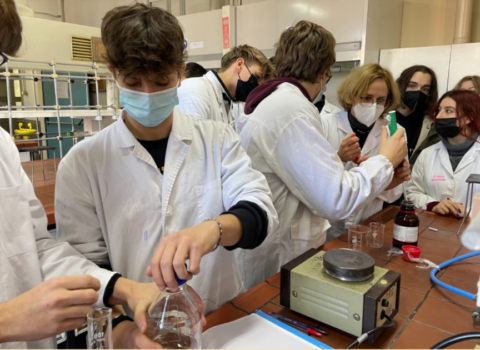
Air-Break, the project under the European Union’s Urban Innovative Actions program, is ending
Air quality goes from acceptable to good thanks to the many initiatives put in place by the project partners: Fondazione Bruno Kessler, City of Ferrara, Deda Next, University of Ferrara, Politecnico di Milano, S.I.P.R.O. Provincial Agency for the Development of Ferrara, Hera Group, Lab Service Analytica.
Thanks to Air-Break, the Municipality of Ferrara has a new, interoperable and heterogeneous data infrastructure, which is essential to guide public policies and take concrete and targeted actions from a sustainability perspective.
According to the Air Break Index * (which is based on data collected by IoT control units installed in some areas of the city) Ferrara’s air quality has improved from “acceptable” to “good” over the past two years. This is the result achieved by the Municipality of Ferrara with Air Break, the project funded under the European Urban Innovative Actions program, which has seen Deda Next, the University of Ferrara, the Politecnico di Milano, S.I.P.R.O. Provincial Agency for the Development of Ferrara, Hera Group, Lab Service Analytica and Fondazione Bruno Kessler at the forefront alongside the Local Administration.
“The Air-Break project has been deemed as a great success,” stressed City Councillor Alessandro Balboni. “In fact, it has won important mentions and awards both nationally and internationally for its innovation content and concrete results. Thanks to the 5 million in European funds that financed Air-Break, we collected an important amount of data on the environment but also on how Ferrara residents travel, in order to develop more effective planning policies. We have built new bikeways and initiated new sustainable mobility systems, involving residents through workshops, awareness campaigns, gamification systems with prizes, encouraging the development of virtuous habits. Our goal is to give the new generations a greener Ferrara, cleaner air and a more livable city,” concludes Councillor Balboni, “and these three years of activities carried out thanks to Air-Break have led us to be a good practice for involvement, innovation and concreteness on a national and international level.
The partners, led by the Administration, were asked to test innovative solutions that would contribute to the reduction of air pollution in selected areas of the city and to carry out educational activities to involve and raise awareness in all citizens (young and old) on environmental issues, encouraging them to make sustainable daily choices.
The starting point for Air Break was the creation of an IT infrastructure, based on Open Source software for the automated acquisition and sharing of interoperable air quality data, built by Deda Next that aggregates information from an IoT technology-based citywide smart grid. This consists of 14 multi-sensor monitoring systems from Lab Service Analytica and 22 control units built through a citizen science initiative by students and teachers from seven high schools in Ferrara. Through the infrastructure, which extends the municipal Local Information System and will continue operating after the project is completed, the municipality now has access to 11 million new data on the air quality and travel habits of its citizens, which can also guide it in the development of future public policies.
The data collected have already enabled the Administration to take concrete and targeted actions based on accurate and up-to-date information on the distribution of air pollution. Starting from the analysis of the information capital collected, in order to encourage sustainable urban travel, in collaboration with the University of Ferrara, a new stretch of smart bikeway (from the Science and Technology Hub to the middle of Corso Isonzo, in conjunction with the bikeways leading to the historic district) has been created equipped with sensors, 2 Digital Totems, “adaptive smart lighting,” and “green” paving composed of a high percentage of partially recycled materials. In total, there are 195 kilometers of bikeway sections within the city and the section built within the AIR BREAK project is 1.25 km. Overall, the use of electric scooters and bike sharing has doubled.
A step forward was also made for the implementation of the car sharing service, thanks to SIPRO’s efforts over the past two years. Starting from the analysis of home-work commute data, carried out with the support of Vodafone, alternative clean commuting solutions were identified for the benefit of businesses in the municipal area, which showed curiosity and interest in particular in the possibility of using Corrente’s 100% electric cars, already present in the city, for the home-work commute. Hence the agreement signed between SIPRO and TPER (Corrente) aimed at incentivizing, through free minute vouchers, the use of the car sharing service for employees of companies located in the Small and Medium Industry area of Ferrara.
An initiative that was immediately welcomed with success by a major company established in the area, which activated promotional credits for its employees, and which is also reaching out to other businesses in the area that are interested in promoting, among their staff, the culture of sustainable mobility, with a view to improving environment well-being and, thus, the lives of residents.
At the same time, 6 green areas (with the experimentation of the Israeli Tal-ya tray) were established in strategic points of the city, including the northern access to the city, the busy Via Bologna, La Fiera, The Cassana and San Luca cemeteries, the city center on the Walls of Via Baluardi, some areas along the bikeway network and the most congested roads, and other relevant aggregation points. Thanks to the planting of 2,300 pollutant-absorbing trees and shrubs, as much as 3,500 kg of CO2 and 660 kg of PM10 were captured in a single year.
In addition, with the aim of identifying effective strategies to reduce the amount of air pollutants, the Hera Group has experimented with the use of a natural and innovative enzymatic product patented by Eurovix, which allows PM10 (atmospheric particulate matter) to be captured on land and prevented from rising into the atmosphere with the passage of means of transport. Through the installation of special nozzles placed on the rear of some street waste collection vehicles, the product was sprayed along the streets of Ferrara, and the 5 campaigns carried out in the 3 years of experimentation contributed to the reduction of PM10 by 20%.
The Hera Group also designed, built and installed 4 protecting roofs to promote sustainable mobility called Smart Hubs, embellishing the city’s bikeways. These infrastructures offer charging stations for bicycles and electric scooters and provide citizens with an SOS emergency system and defibrillator (AED), a bicycle maintenance kit, and electrical outlets for charging electronic devices and electric wheelchairs. Soon it will be possible to activate free Wi-Fi from the Emilia Romagna Region, video surveillance, as well as a cabinet for e-commerce parcel storage. The protecting roofs are sustainable, as they are made of photovoltaic panels to produce renewable power.
Ultimately, the data collected on their use can be consulted through a digital dashboard designed by Hera within which an air pollution forecast modeling service, satellite mapping of PM10, and a social sentiment analysis service on Air-Break topics have been developed.
Central to Air Break is also the involvement of people, which is essential to create awareness and knowledge on air quality issues and to promote the use of the equipment and technologies deployed by the project. Under the coordination of the Milan Polytechnic, an alliance of actors and citizens actively involved in the participation and co-creation of new activities was activated and mobilized during the three years of the project, aimed at understanding the factors that determine air quality and the responsibilities and roles that each actor can assume to improve current conditions. ’ Several workshops on the living lab model were promoted and a physical point of reference was established in the city, “FerrAria,” the city information center on air quality that hosts an exhibition and guided tours. Finally, the establishment of the “Feste dell’Aria,” an annual festival, launched in October 2021 and now in its third year. Hosted at the Open Laboratory, the Air Festival is the result of close collaborations with the fabric of the city, involving more than 300 people each year, including citizens, students and experts, in creating together with project partners a series of events open to different target audiences to jointly address the improvement of air quality.
The data collected on air quality have been made available to residents; a citizen dashboard, created by the collaboration between Deda Next and the Politecnico di Milano, on the Air-Break website allows people to understand in an intuitive and easy way the amount of polluting particles in the atmosphere and, therefore, to make more conscious choices about the use of means of transportation. Also available is a page dedicated to “local metabolism,” which allows people to view the impact of traffic in different areas and time slots and to check how busy the bikeways are.
Thanks to the digital platform Play&Go (https://playngo.it/), developed by Fondazione Bruno Kessler (FBK) and which allows tracking citizens’ sustainable travel (on foot, by bike, bus, train, or car-pooling), the municipality has also initiated several mobility challenges.
Play&Go promoted the use of sustainable means of transportation by engaging citizens in customized challenges with numerous weekly and final prizes for locally organized activities, which were provided directly by SIPRO, by virtue of its partnership with FBK in the implementation of the activities. In the two editions held between 2022 and 2023, the about 2,500 participants covered as 400,000 kilometers travelling green. Their choice resulted in savings of as much as 90 tons of CO2.
Bike to Work, designed to disincentivize the use of private vehicles to commute to work, instead involved, from May 2021 to October 2023, 70 Ferrara businesses of all sizes and about 1,000 workers who traveled 641,000 kilometers by bicycle, saving 173 tons of CO2.
The High School Challenge, which took place between March and May 2023, encouraged students (aged 14 and above) to move without contributing to pollution on their home-school commute and in their leisure time. A project that, through mechanisms of intra-class cooperation and inter-class competition, involved 170 high school students who, through their green choices, prevented about 2 tons of CO2 to being put into the environment.
Even little ones played their part. 500 primary and secondary school children took part in three different editions of Kids Go Green, the educational game that involved the entire school community (students, families, and teachers) in exploratory trips while traveling to and from school. This resulted in more than 50 percent reduction in car use.
Overall, between sustainable mobility campaigns, events and online engagement, the Air Break project has affected about 22,000 Ferrara citizens, helping to spread a sustainability culture within the city. This is a key element that, when added to the tools and best practices acquired during the project, will enable the Municipality of Ferrara to continue promoting sustainable transition in the local area.
*The Air Break Index is a synthetic air quality index referring to the urban area of Ferrara that is calculated from the values obtained from the experimental control units of the European AIR-BREAK project. Each control unit measures 6 air quality parameters (PM2.5, PM10, NO2, O3, CO, VOC) as well as 3 climatic parameters (temperature, relative humidity, atmospheric pressure). The first 5 air quality parameters (PM2.5, PM10, NO2, O3 and CO) are used to calculate the synthetic index. The worst parameter is considered as an index: it is a dimensionless value with a scale from 0 (good) to over 100 (worst), so as to facilitate understanding by those unfamiliar with numbers, measurement units and legal thresholds. Specifically, the scale consists of the following ranges: good, acceptable, mediocre, poor, unacceptable, and very bad.

